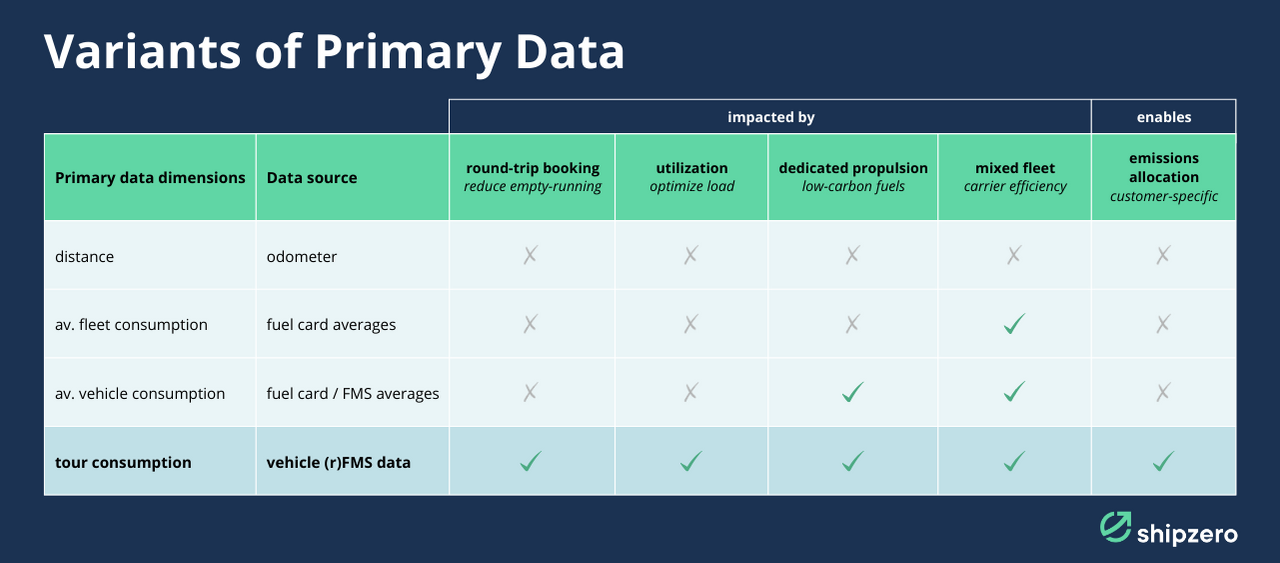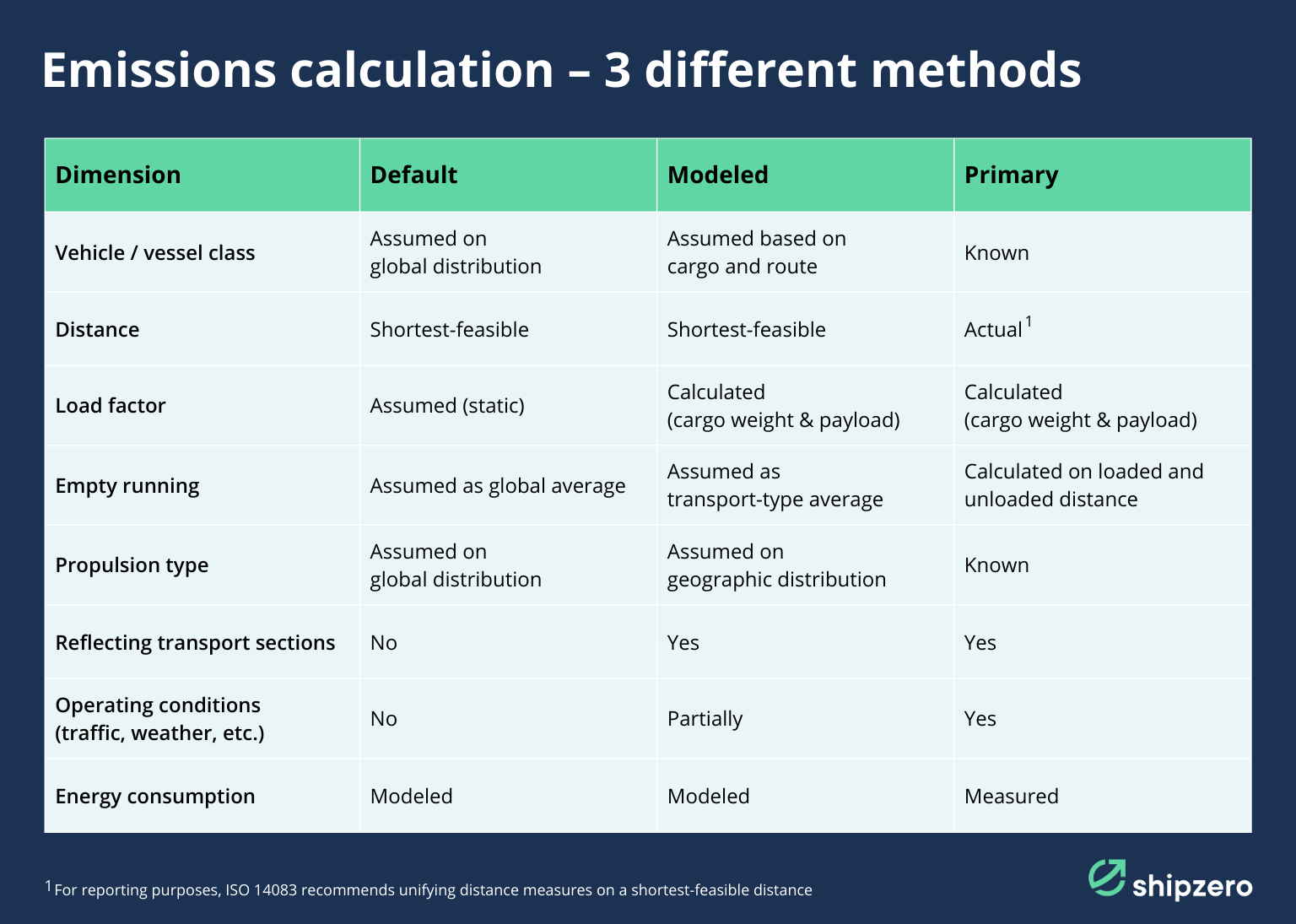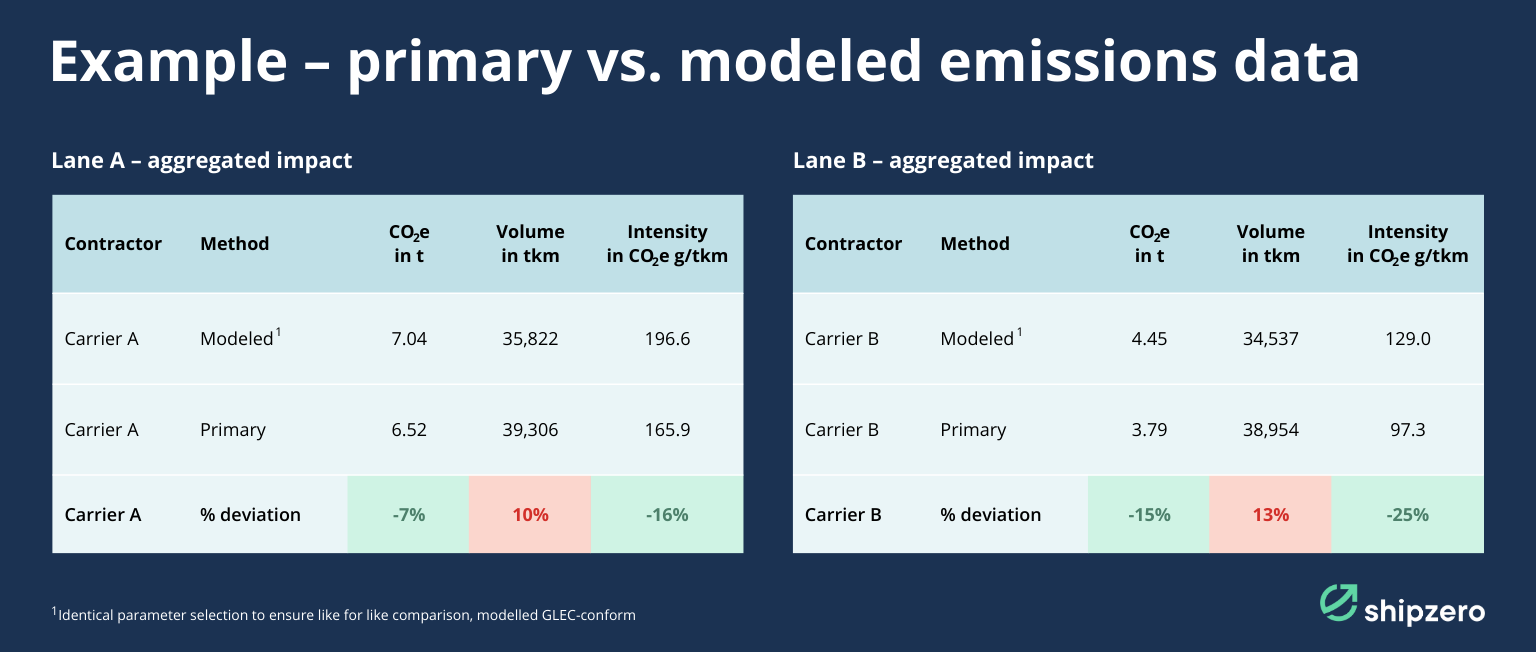Transport emissions are a major contributor to global greenhouse gas output, around 21%[1] globally, 25% in Europe[2] and 28% in North America[3]. Freight transportation accounts for roughly 30% of this emissions share. Accurate emissions calculation is crucial for effective policymaking and climate action. Primary data stands as the linchpin for reliable emissions assessment, offering desperately seeked insights that can drive successful decarbonization measures, while at the same time saving operational costs.
Understanding primary data in emission calculations
Primary data’s role in emissions accounting is fundamental. They provide the most accurate measurements of transport emissions as they are based on actual fuel consumption.
The following overview shows four different dimensions of primary data that are commonly associated with primary (measured) input values for emissions reporting. However, only the level of individual tour consumption allows for a precise analysis of measures to which fleet owners or transport buyers can act on.
Methods of calculating CO2 emissions
To understand the importance of primary data, it is necessary to briefly outline the ways transport emissions can be legitimately calculated today. The biggest hurdle is data accessibility and granularity of information available to the respective stakeholders of a scattered logistical network with many partners operating on very different IT and data management levels of sophistication.
Taking the internationally most recognized standards ISO 14083 or GLEC Framework 3.0 from 2023, there are three different methods on how to assess the greenhouse gas output of a transport.
Four important things to know when calculating emissions:
- The Primary data label shall only be used when the energy consumption is based on measurement from sensors (telematics) or fueling events.
- GPS signals alone are sensory data but do not provide value in terms of the energy consumption and should therefore not be labeled as primary data
- Modelled and Default data are always activity-based, meaning that the crucial part of energy consumption is based on a calculation or assumption.
- Depending on the transport characteristics there are mixed forms between the approaches (e.g. less-than-truckloads), that are relevant for the allocation of emissions to individual goods.
Assessing the quality of a modeled approach is not straightforward. Modelling can return very precise results, if a lot of influencing parameters are known, on the other hand, it can also be only of little additional insight compared to default values, if the data sources do not allow for further calibration of the model. The nuances of vehicle types, fuel usage, and operating conditions are all captured implicitly already in primary data, making it invaluable for a detailed emissions inventory. The calculation method is not fully a suitable dimension to judge the quality of the data set alone, but it provides a first orientation.
An example – the deviation between primary data and modeled data
As already highlighted, the utilization of primary data enables greater precision in emissions measurement compared to other calculation models. The example below illustrates the deviations of primary data between modeled data. It shows a like for like comparison of the exact same transports for one carrier and one month on two specific trade lanes. The assumptions made for the modeled data are based on the same information available for both analyses, except for the primary fuel measurement and the actual distance.
In the example shown, the volume in tkm (distance*cargo weight) is higher if primary data is used. The data from the telematics reflects the exact distance traveled, whereas the modeled method only assumes an approximate distance, although it is the shortest-feasible. Nevertheless, the emissions intensity in this example is lower when using primary data, as it is based on actual fuel consumption, while the modeled method relies on conservative assumptions. The more information is missing for the emissions calculation (e.g. vehicle type, load factor), the more assumptions have to be made. Effective measures to reduce emissions, such as driving behavior, can therefore not be made visible using a modeled based method alone.
In summary, both data sets in the example show significant deviations from the average calculation for both actual distance and total emissions, which can be attributed to efficient and modernized fleets and real driving behavior. This illustrates how important it is to rely on tracking data for optimization purposes.
Technologies and regulations shaping data acquisition
Primary data in transport can be gathered using advanced on-board diagnostics (OBD), and fuel purchase records, among other techniques. While each method has its merits, they also come with challenges like technical complexity and cost considerations. However, when employed effectively, these methods yield data that can transform our understanding of transport emissions.
Technological advancements, such as IoT and telematics, have revolutionized data capture. Meanwhile, the regulatory landscape is also reshaping data usage. The European Data Act, for instance, aims to facilitate data sharing and usage across the EU. It will have a significant impact on how transport emissions data is collected, shared, and utilized, ensuring greater standardization and accessibility.
In other areas standardization of industry protocols benefits the ability of using primary data, e.g. the (Remote) Fleet Management Standard (FMS/rFMS) in vehicle telematics or the aim to standardize ship reporting (Noon reporting). Still, the market is at a very early stage of data acquisition as most IT and databases have been built for managing transactional records of freight, rather than being a replica of the real-world freight movement.
Challenges and best practices in primary data utilization
Despite its potential, using primary data effectively is not without its hurdles. Issues like data privacy, intricate management systems, and the need for standardization persist. By adopting best practices that address these concerns, stakeholders can harness the full power of primary data, unlocking new opportunities for emissions reduction. Two industry best practices, which already calculate their emissions based on primary data are the transport companies RINNEN and Weigand Transporte.
The main challenge to overcome is the exchange of primary data throughout multi-staged transport networks on a reliable basis. This implies that transport operators who actually conduct the transport offer services that provide ex-post emissions data on individual shipment- and client level to their direct customers. These are oftentimes forwarders who themselves need to process the records, combine the primary data input in a multimodal transport to a door-to-door transport chain, and then forward them as well to their customers (BCOs, Shippers).
To achieve this level of transparency, each stakeholder needs to have a reliable and standardized data management system in place and communicate the data without significant human involvement through APIs and a standardized protocol that can be used also by the variety of different software vendors for planning, dispatchment and freight booking in the logistics industry.
Outlook: Big Data’s role for dynamic emissions factors
Big data and analytics are pivotal in developing sophisticated emissions models. These models are increasingly relying on dynamic emission factors which reflect the evolving nature of transport fleets, offering a more accurate picture than static models. By analyzing large datasets, it’s now possible to extrapolate emissions profiles for specific transport categories, enhancing the granularity and applicability of emissions data.
Until now, emission factors provided by institutions such as the Smart Freight Centre are static and valid for a year, if not significantly longer. Some areas where comparably little research is conducted, e.g. inland waterway transports, the base for assessing emission factors can be very small. Only a few transports can already make up the basis for statistical factors that are used by an entire industry and may not be as representative as needed.
With a rapidly up taking mixture of propulsion technologies and (synthetic/bio) fuel used in fleets, it will be even harder to keep up with the static approach, which is why a transition to a more dynamic approach is inevitable in the upcoming decade.
Policy implications and future directions
A few years back, the perception of this becoming a reality was very pessimistic. Too many stakeholders, and too many legacy systems being involved to allow for a rapid transformation. Meanwhile, research projects have been conducted, first protocols have been developed, and major industries such as the automotive industry double down on primary data as the only valid option to avoid a great chaos of greenwashing in the future.
Not all hurdles have been removed, but the willingness to share data under a fair and transparent governance framework has become significantly higher. Policies like the European Data Act contribute to this development. Many software vendors and market players have recognized the relevance of incorporating carbon emission data into their systems. However, without clear labeling between default, modeled and primary data, this also leads to confusion for companies defining their strategy and assessing where to get their ground truth data from.
The intelligent use of primary data has far-reaching implications for transport policy. It can guide legislation on new emissions standards, inform infrastructure planning, and fuel the development of sustainable transport technologies. The responsibility for market participants is establishing a cohesive and comprehensive approach to transport emissions management in the years to come. And this approach needs to be built on accuracy and primary data infusion, wherever possible to avoid an oversimplified accounting system and any room for greenwashing and manipulation.
Conclusion
The integrity of transport emissions calculations has never been more crucial. With the strategic application of primary data, complemented by cutting-edge technologies and regulatory support, the transport sector is poised to make significant strides in emissions reduction. This is not done overnight. It will take years to build up the required infrastructure, processes, and agreements with partners. But the effort will pay off in a much more reliable picture of supply chain activities overall, and a resilient fundament to take decarbonization decisions that impact large investment amounts. The journey towards a low-carbon future for transport is underway, with data leading the change.
—
[1] https://www.statista.com/statistics/1129656/global-share-of-co2-emissions-from-fossil-fuel-and-cement/
[2] https://www.eea.europa.eu/en/topics/in-depth/transport-and-mobility
[3] https://www.epa.gov/ghgemissions/sources-greenhouse-gas-emissions






